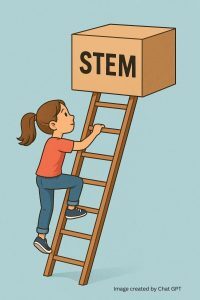No More Backsliding!

I was sad but not surprised to read the results of the National Science Foundation’s meta-analysis of gender-stereotyping of children. They conclude that “at age 6, children already believe that boys and men are better at computing and engineering; girls increasingly endorse this belief in older ages. These stereotypes therefore have ample time to affect children’s motivations and behaviors as children engage with these subjects in formal schooling and select diverging pathways in later grades.” (psycnet.apa.org)
Nearly thirty years ago I first encountered articles and studies about why girls were avoiding math and science classes at ever earlier ages. Although I’m an English teacher and writer, the rest of my family is in STEM fields, and I see how important they are and the opportunities they offer. Even though I ran three other extracurricular activities, I started a group called WIMS [Women in Math and Science]. We met after school every month to look at the research and plan activities. I connected them with women scientists at Fermilab, and they reached out to girls at the middle school and grade schools. I was hopeful.
I wasn’t entirely wrong. We did make progress.
But we’re slipping again. According to Northwest Evaluation Association research, although the disparity between middle school math and science scores disappeared in 2019, the gap has returned. One author posited that teachers may be reinforcing old stereotypes and/or the renewed focus on boys’ learning after they fell behind may affect girls. Whatever the reason, we’re losing ground here. (www.the74million.org)
Indianapolis schools have tackled this issue by creating Girls IN STEM Academy. Its mission: “Helping elementary-age girls’ science hopes take flight.” They’ve enrolled 65 girls but plan to grow to 300. The Girl Scouts are a partner. Purdue Polytechnic High School students will mentor the girls, seeking to create a pipeline that eventually boosts the female attendance there, as well as at colleges.
“With women making up just a third of the STEM workforce and about the same majoring in STEM fields in college, according to the Massachusetts Institute of Technology and American Association of University Women, experts see a need to start encouraging girls early in a STEM focus.” The article claims that there are only three other girls elementary schools with a dedicated STEM focus — Innova Girls Academy in New York, Rise STEM Academy for Girls in Kentucky and Solar Preparatory School for Girls in Texas. (indianacapitalchronicle.com)
Girls make up nearly half the population of school-age children, and our country cannot afford to discard their talents. STEM careers are highly desirable, and girls should be encouraged to seek them along with boys. Early support of STEM makes a difference. “Researchers have found that high-quality academic preparation and exposure to STEM is a key influence in high schoolers’ chances of landing a STEM career.” (www.the74million.org2)
It’s time for change.



